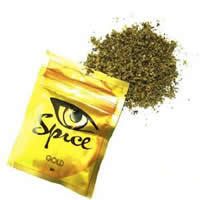Cannabinoid-receptor inverse-agonist drugs can be used as antidotes to rescue people overdosing on synthetic cannabinoids (widely marketed as “Spice,” “K2,” etc.). So suggests a paper in the British Journal of Pharmacology by Gareth Pryce and David Baker, researchers from Queen Mary University of London.
It has long been established that CB1-receptor inverse-agonist drugs, administered in advance of cannabinoid use, can block intoxication. Pryce and Baker were investigating whether the “effects of a synethic cannabinoid could be reversed after they are manifest.”
Working with mice, they administered 5mg/kg of the antagonist drug AM-251 20 minutes after intoxication was induced by an agonist drug, CB-13. It then took 20 minutes for the antagonist to overcome sedation and 40 minutes to restore body temperature to normal.
The authors note that Spice et al are “unlicensed, lack proper toxicology testing and have variable content.” Harmful effects attributed to these drugs
“may relate to the actions of toxic metabolites on alternative targets unrelated to the cannabinoid system or possibly non-cannabinoid compounds. The physical effects usually reported include tachycardia, nausea, somnolence, hallucinations, paranoia and dry mouth syndrome (xerostomia) typical of cannabis intoxication. However, atypical cannabis intoxication effects and worse complications such as psychosis, seizures, flaccid paralysis, renal injuries, aggressiveness, cerebral ischaemia, cardiac arrhythmias, myocardial infarction, coma and death have all been reported following the use of synthetic cannabinoids (Kemp et al., 2016; Tournebize et al., 2017)… Because there is not enough data to be confident that the toxicity of the ‘Spice’ products is really due to their cannabinoid content, perhaps the best way of determining whether this is the case would be to undertake a trial of a rescue cannabinoid receptor antagonist.
The authors remark the fate of Rimonabant, a cannabinoid antagonist approved by regulatory authorities in Europe a decade ago as a treatment for “Metabolic Syndrome.” Sanofi-Aventis withdrew its hoped-for blockbuster from the market after a pattern of adverse effects emerged —including “suicidal ideation” that sometimes got acted on. Although these adverse events did not “justify its longterm use,” according to Pryce and Baker,“single-use cannabinoid antagonist therapy to block potentially life-threatening, cannabinoid intoxication may be worth the re-manufacture and testing for such an indication.”
They seem to be inviting Sanofi to make Rimonabant available as an antidote:
“Proof of concept studies of p.o. [oral] formulations, for which there is toxicological data and knowledge from human use, could be administered to people who are conscious and compliant. This may help determine whether the investment required to develop an i.v. formulation for use by paramedics or more importantly an i.m. [intramuscular] formulation for use in an emergency autoinjector is justified. Because of the knowledge associated with their use in humans, it would be easier to develop one of the antagonists/inverse agonists that have entered clinical development, notably rimonobant, as it would have a large history of human use and is known to antagonize some of the chemical entities found in ‘Spice’ (Hruba and McMahon, 2017)…
“Just as naloxone can be used to limit the effects of opioid overdose, single-use CB1 receptor inverse agonists could perhaps help save human life.”
Baker contacted Sanofi directly. “They weren’t interested,” he reports.
This study was a kind of side gig for Baker and Pryce, whose research over the years has focused on Multiple Sclerosis. Baker updated O’Shaughnessy’s:
“We are focusing on the BKCa potassium channels through which some cannabinoid receptors signal. We made a compound based on a cyclic anadamide designed to be a CNS excluded cannabinoid but it turned out although it was blocked by rimonabant it hits this channel and in the next week or so we will hear if it worked in our MS trial.”
It makes sense that ERs and paramedics should have a receptor-blocker on hand to treat synthetic cannabinoid overdoses. Of course there would be no such overdoses in the first place if the prohibition of herbal marijuana hadn’t created a market for Spice et al.
Here’s some relevant background on Rimonabant and Spice and an almost topical song. —FG





